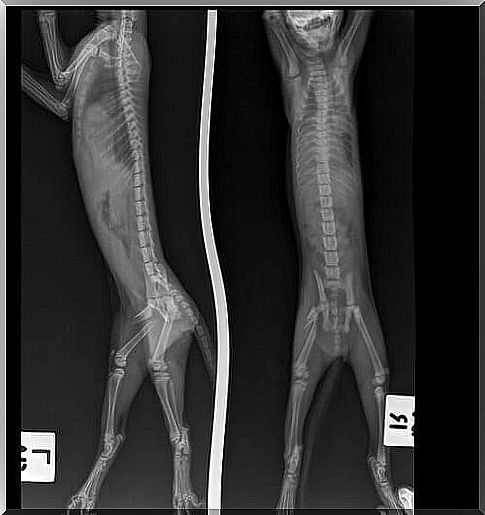Limping Cats: Common Causes And Treatment

Many pains that affect the joints, muscles, bones, nerves or skin can form the cause that lies behind limping cats. In the list of possible problems, some are more serious than others; therefore, be very careful.
It is clear that if your cat has been hit by a moving vehicle, or has fallen out of a window, there will be nothing strange in the fact that he cannot walk normally. However, sometimes the cause of the lameness is not that obvious or that dramatic.
As a result, it will be helpful for you to know more about the causes of lameness in cats, what symptoms to look out for and how you can help your kitten.
Lameness as a symptom
A cat that cannot walk, run or jump normally can be considered limping. It is possible, however, that even if the cat is suffering from noticeable pain, the affected extremity may have an abnormal appearance.
It is important to remember that lameness is a clinical sign of another disease and is not, in itself, a diagnosis. Hence, many diseases can cause lameness, and affected cats can exhibit a variety of symptoms in addition to stressed lameness.
For this reason, it is important to observe any loss of appetite, increased vocalization, numbness, vomiting, weight loss, increased water consumption or increased urine volume.
Causes commonly associated with limping cat cases
Generally, lameness in cats results from an injury or disease affecting the musculoskeletal or nervous systems. Changes affecting the bones, muscles, tendons, ligaments, and nerves can cause lameness.
Furthermore, lameness also occurs due to other systemic diseases, such as diseases that affect the immune system. Of course, some infectious diseases, malnutrition, cancer, or diabetes can also cause lameness.

In the following lines, we provide you with a list of the most common causes of lameness in cats:
1. Trauma or injury
- Muscle sprains or strains.
- Bruise.
- Tendinitis.
- Myositis.
- Snake or other animal bite.
- Fracture.
- Broken nail.
- Paw pad laceration.
- Presence of a foreign body in the paw pad (thorns, quills, glass splinters, etc.).
- Freezing or burning of the paw pad.
2. Nervous disorders
- Paralysis of the radial nerve.
- Discospondylitis.
- Mild cerebrovascular event.
3. Joint pathology
- Hip dysplasia.
- Degenerative joint disease or osteoarthritis.
- Joint dislocation.
4. Systemic pathologies
- Autoimmune disease, including progressive polyarthritis.
- Bone cancer.
- Viral infections, such as calicivirus.
- Diabetes.
- Developmental or congenital pathologies.
Limping cats and diagnostic procedures
It is necessary to emphasize the importance of getting a correct diagnosis, to prevent the cat from developing permanent muscle or nerve disorders. Your vet will perform a complete physical examination of your cat in order to determine the exact source of the problem.
The age of your cat, any history of any trauma, the beginning of the problem (acute or chronic), the severity of the lameness and the number of legs involved are indicators of the possible source of the problem.
Diagnosis of limping cats may require specific tests. It often happens that these include one or more of the following analyzes:
- X-rays.
- Biopsies.
- Blood tests for infectious or immune-associated diseases.
- Collection and analysis of synovial fluid.
- More accurate diagnoses may require the use of ultrasound, computed tomography, or magnetic resonance imaging.
Care of limping cats: treatment
In addition to treating the cause of a cat’s lameness, vets also want to control the pain the animal is suffering. Generally, they start with a minimally invasive treatment, and then move on to a more invasive pain treatment if the former does not give the desired results.

The first choice is pain medications. First, non-steroidal anti-inflammatory drugs will be used, which reduce inflammation of the joints or ligaments.
While the cat receives this treatment, he is closely monitored by the veterinarian. The aim is to make sure that no kidney, liver or gastrointestinal damage develops. Along with this form of treatment, the vet can prescribe rest inside the cage.
If NSAIDs (non-steroidal anti-inflammatory drugs) don’t work, your vet will prescribe opioid pain relievers, such as tramadol, buprenorphine, or butorphanol. These drugs are used only for the most acute pain.
In the case of osteoarthritis, medicines that protect the cartilage surrounding the joint may be helpful. They are used to delay the deterioration of the cartilage in the affected extremity.
In addition, treatments that help control pain may be helpful. These include chiropractic treatments, acupuncture and physiotherapy, as well as laser therapy.
Finally, other treatments can include massage and dietary changes. If your cat has a congenital condition that limits the use of the extremity or causes significant pain, the vet may suggest surgery.
Your vet will prescribe the most suitable treatment to improve the condition of your limping cat. Consequently, it is very important that you follow all his instructions exactly as prescribed.









